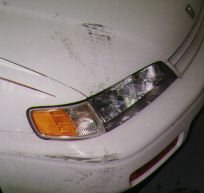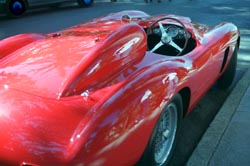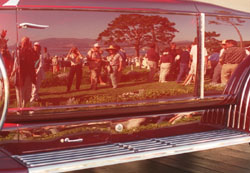|
|
||
 |
 |
|
|
|
||
|
|
||

|
||

|
||

|
||

|
||

|
||

|
||

|
||

|
||

|
||

|
||

|
||

|
||

|
||
|
|
Polish has come to be almost a generic term that refers to the detailing process as a whole. You might hear someone say "Jane spent three days polishing that car" when in actuality the three days were spent doing a number of detailing tasks. Polishing, as it applies to car detailing, refers to the act of restoring gloss by removing contaminants, restoring valuable oils and smoothing the paint surface. Most polishes accomplish this by being a mild abrasive and some do it by way of a chemical reaction. Our options
We have three basic choices when it comes to treating paint surfaces:
Each of these work by removing unwanted paint, in very small amounts, from the surface of the paint. They vary in their "aggressiveness". Rubbing compound removes the most amount of paint for a given application while polishes remove the least, with cleaners somewhere in between. Obviously, removing paint should be taken seriously. The trick is to use a product with the right amount of aggressiveness. For this reason, we recommend starting with an application of polish. If the polish does not seem to have enough of an effect, try an application of cleaner. Using an orbital buffer will make the job go much faster. However, the polish or cleaner should be designed for machine use. If a cleaner or polish application doesn't get the job done, rubbing compound may be the solution. Rubbing compound is a strong abrasive however, and should be taken seriously. For that reason, we recommend that you turn the task over to a professional. Polishes serve to remove contaminants on the paint surface. This can include airborne pollutants, tree sap, bird droppings and so on. For many detailers, this function can best be accomplished by claying. You're decision to use polishes or cleaners will depend on the condition of your paint and so it is difficult to give any hard and fast recommendations. If the paint looks dull after washing, a polish application could be the next step. If the paint is very dull, to the point of having a certain amount of roughness to the texture, then an application of cleaner is in order. Prime candidates are cars that have not been detailed for a long time and used or even new car purchases.

Swirls
Swirls are those nasty circular lines that show up in bright sunlight and go a long way towards preventing your car from looking "right". They are best thought of as microscopic scratches and are usually the result of poor detailing practices. There is a reason why "avoiding scratches" is rule #1!
There are a number of swirl removal products available. Some are basically polishes that work by dulling the edges of the scratches; this might not remove the scratches entirely but it can help out the situation considerably. Others work as fillers, placing material in the scratch so that they effectively disappear. Wax and glazes perform a similar function. If you are not satisfied with the results of your swirl remover treatment, consult a detailing professional. Oxidation
The finish of a car is always wet, even if it is dry. To make sense of this
statement, consider the fact that paint needs certain oils to keep its fresh glossy look. Ultraviolet rays from the sun and smog can dry up these essential oils, and the result is a dull and flat finish known as oxidation. If you could look at oxidized paint under a high powered microscope, you would see a surface that looks dry and cracked like the desert.
When it occurs, oxidation appears as dull and dry spots on the finish and usually is first noticed on the flat horizontal areas of the car. If paint residue appears on your wash mitt, you definitely have an oxidation problem. The solution to oxidation is to remove the uppermost surface of dead paint. To do that we have three basic choices: Important Notes:
 Here is an example of where a cleaner was useful. A piece of rubber lying on the freeway which used
to be a part of a trucks' retread tire was kicked up by a car and flew backwards, hitting the
fender of this Honda. The sheet metal was not affected, but it left its mark in the surface of
the paint. An application of Meguiar's Deep Crystal System Paint Cleaner took care of it nicely.
The affected area was then rewaxed. Here is an example of where a cleaner was useful. A piece of rubber lying on the freeway which used
to be a part of a trucks' retread tire was kicked up by a car and flew backwards, hitting the
fender of this Honda. The sheet metal was not affected, but it left its mark in the surface of
the paint. An application of Meguiar's Deep Crystal System Paint Cleaner took care of it nicely.
The affected area was then rewaxed.
|
||||
|
Polish/Wax Jobs That Set The Standard!
|
||||
|
||||
|
||||

|
||||

Suggestions? Comments? Tricks that you have found work well? Tell us!!! |

|

|




